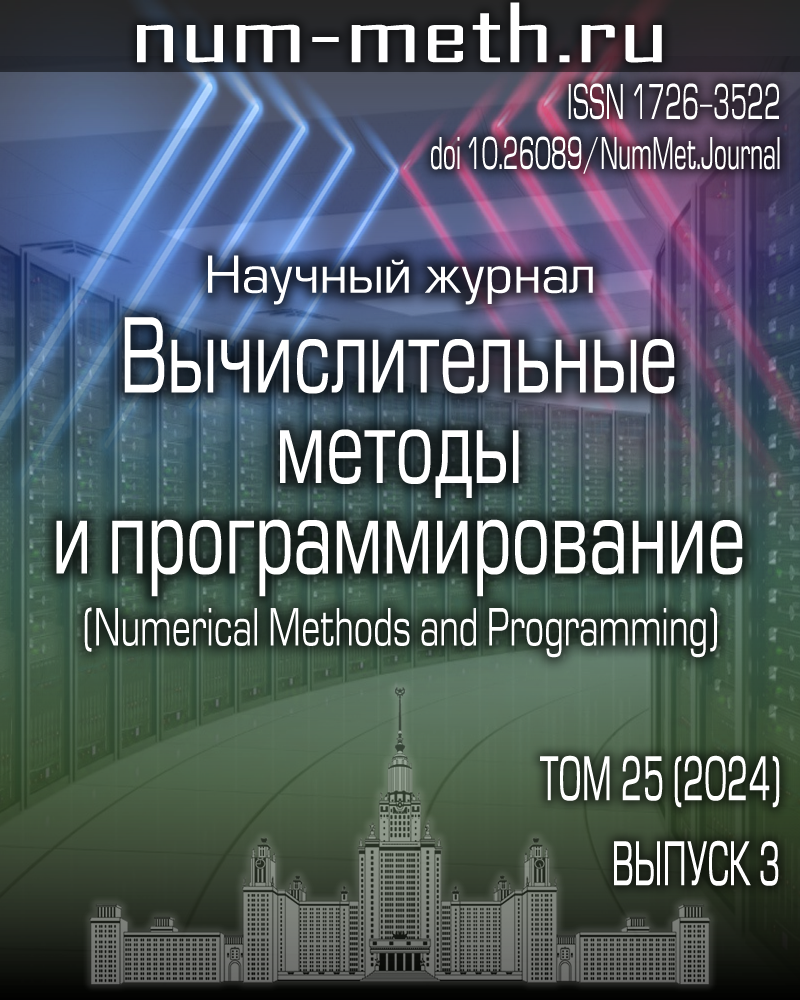DOI: https://doi.org/10.26089/NumMet.v25r320
Применение алгоритмов решения проблемы булевой выполнимости для анализа финалистов конкурса SHA-3
Ключевые слова:
Аннотация
Рассматриваются финалисты конкурса SHA-3, организованного для принятия нового стандарта криптографической хеш-функции. Все пять финалистов до сих пор являются стойкими к поиску прообраза, т.е. для них невозможно за реальное время найти вход по известному выходу. Исследуется возможность нахождения прообразов неполнораундовых версий рассмотренных криптографических хеш-функций. Соответствующие задачи сведены к проблеме булевой выполнимости (SAT) с помощью инструментального средства CBMC, предназначенного для проверки свойств программ на языке C. Для решения построенных экземпляров SAT использован современный решатель Kissat. В сравнении с ранее опубликованными результатами, для четырех из пяти функций-финалистов удалось найти прообразы более сложных неполнораундовых версий.
Опубликован
Выпуск
Раздел
Библиографические ссылки
- T. H. Cormen, C. E. Leiserson, R. L. Rivest, and C. Stein, Introduction to Algorithms (MIT Press, Cambridge, 2001; Williams, Moscow, 2013).
- A. P. Alferov, A. Yu. Zubov, A. S. Kuz’min, and A. V. Cheremushkin, Fundamentals of Cryptography (Gelios ARV, Moscow, 2002) [in Russian].
- G. V. Bard, Algebraic Cryptanalysis (Springer, New York, 2009).
doi 10.1007/978-0-387-88757-9 - F. Massacci and L. Marraro, “Logical Cryptanalysis as a SAT Problem,” J. Autom. Reason. 24 (1-2), 165-203 (2000).
doi 10.1023/A: 1006326723002 - M. R. Garey and D. S. Johnson, Computers and Intractability: a Guide to the Theory of NP-Completeness (W. H. Freeman, San Francisco, 1979).
- J. P. Marques-Silva and K. A. Sakallah, “GRASP -- a New Search Algorithm for Satisfiability,” in Proc. Int. Conf. on Computer Aided Design, San Jose, USA, November 10-14, 1996.
doi 10.1109/ICCAD.1996.569607 - R. Impagliazzo, L. A. Levin, and M. Luby, “Pseudo-Random Generation from One-Way Functions,” in Proc. Twenty-First Annual ACM Symposium on Theory of Computing, Washington, Seattle, USA, May 14-17, 1989.
doi 10.1145/73007.73009 - I. Mironov and L. Zhang, “Applications of SAT Solvers to Cryptanalysis of Hash Functions,” in Lecture Notes in Computer Science (Springer, Berlin, 2006), Vol. 4121, pp. 102-115.
doi 10.1007/11814948_13 - First SHA-3 Candidate Conference.
https://csrc.nist.gov/events/2009/first-sha-3-candidate-conference . Cited June 21, 2024. - E. Homsirikamol, P. Morawiecki, M. Rogawski, and M. Srebrny, “Security Margin Evaluation of SHA-3 Contest Finalists through SAT-Based Attacks,” in Lecture Notes in Computer Science (Springer, Berlin, 2012), Vol. 7564, pp. 56-67.
doi 10.1007/978-3-642-33260-9_4 - J. A. Buchmann, Introduction to Cryptography (Springer, New York, 2004).
doi 10.1007/978-1-4419-9003-7 - P. Rogaway and T. Shrimpton, “Cryptographic Hash-Function Basics: Definitions, Implications, and Separations for Preimage Resistance, Second-Preimage Resistance, and Collision Resistance,” in Lecture Notes in Computer Science (Springer, Berlin, 2004), Vol. 3017, pp. 371-388.
doi 10.1007/978-3-540-25937-4_24 - H. Feistel, “Cryptography and Computer Privacy,” Sci. Am. 228 (5), 15-23 (1973).
doi 10.1038/scientificamerican0573-15 - C. E. Shannon, “Communication Theory of Secrecy Systems,” Bell Syst. Tech. J. 28 (4), 656-715 (1949).
doi 10.1002/j.1538-7305.1949.tb00928.x - R. C. Merkle, “A Certified Digital Signature,” in Lecture Notes in Computer Science (Springer, New York, 2001), Vol. 435, pp. 218-238.
doi 10.1007/0-387-34805-0_21 - I. B. Damgaard, “A Design Principle for Hash Functions,” in Lecture Notes in Computer Science (Springer, New York, 2001), Vol. 435, pp. 416-427.
doi 10.1007/0-387-34805-0_39 - C. Paar and J. Pelzl, “Hash Functions,” in Understanding Cryptography (Springer, Berlin, 2010), pp. 293-317.
doi 10.1007/978-3-642-04101-3_11 - R. F. Kayser, “Announcing Request for Candidate Algorithm Nominations for a New Cryptographic Hash Algorithm (SHA-3) Family,” Federal Register. 72 (212), 62 (2007).
- G. Bertoni, J. Daemen, M. Peeters, and G. Van Assche, “Keccak,” in Lecture Notes in Computer Science (Springer, Berlin, 2013), Vol. 7881, pp. 313-314.
doi 10.1007/978-3-642-38348-9_19 - J.-P. Aumasson, W. Meier, R. C.-W. Phan, and L. Henzen, The Hash Function BLAKE (Springer, Berlin, 2014).
doi 10.1007/978-3-662-44757-4 - P. Gauravaram, L. R. Knudsen, K. Matusiewicz, et al., Gro stl -- a SHA-3 Candidate,
https://drops.dagstuhl.de/storage/16dagstuhl-seminar-proceedings/dsp-vol09031/DagSemProc.09031.7/DagSemProc.09031.7.pdf . Cited June 21, 2024. - N. Ferguson, S. Lucks, B. Schneier, et al., The Skein Hash Function Family. Submission to NIST (Round 3). 2010.
- H. Wu, The Hash Function JH. Submission to NIST (Round 3). 2011.
- B. Preneel, “The State of Hash Functions and the NIST SHA-3 Competition,” in Lecture Notes in Computer Science (Springer, Berlin, 2009), Vol. 5487, pp. 1-11.
doi 10.1007/978-3-642-01440-6_1 - SHA-3 Finalists Announced by NIST.
https://web.archive.org/web/20110709093032/
http://crypto.junod.info/2010/12/10/sha-3-finalists-announced-by-nist/. Cited June 21, 2024. - D. J. Bernstein, ChaCha, a Variant of Salsa20.
https://cr.yp.to/chacha/chacha-20080120.pdf . Cited June 21, 2024. - E. Biham and O. Dunkelman, “A Framework for Iterative Hash Functions -- HAIFA,” Cryptology ePrint Archive, Paper 2007/278.
https://eprint.iacr.org/2007/278 . Cited June 21, 2024. - S. Lucks, “A Failure-Friendly Design Principle for Hash Functions,” in Lecture Notes in Computer Science (Springer, Berlin, 2005), Vol. 3788, pp. 474-494.
doi 10.1007/11593447_26 - J. Daemen and V. Rijmen, The Design of Rijndael (Springer, Berlin, 2002).
doi 10.1007/978-3-662-04722-4 - A. Biere and M. Fleury, “Gimsatul, IsaSAT and Kissat Entering the SAT Competition 2022,” in Proc. SAT Competition 2022 - Solver and Benchmark Descriptions , Vol. B-2022-1, pp. 10-11. University of Helsinki, 2022.
- V. S. Kondratiev, A. A. Semenov, and O. S. Zaikin, “Duplicates of Conflict Clauses in CDCL Derivation and Their Usage to Invert Some Cryptographic Functions,” Numerical Methods and Programming. 20 (1), 54-66 (2019).
doi 10.26089/NumMet.v20r106 - O. Zaikin, “Inverting 43-Step MD4 via Cube-and-Conquer,” in Proc. IJCAI-ECAI, Vienna, Austria, July 23-29, 2022.
doi 10.24963/ijcai.2022/263 - E. Clarke, D. Kroening, and F. Lerda, “A Tool for Checking ANSI-C Programs,” in Lecture Notes in Computer Science (Springer, Berlin, 2004), Vol. 2988, pp. 168-176.
doi 10.1007/978-3-540-24730-2_15 - A. Semenov, I. Otpuschennikov, I. Gribanova, et al., “Translation of Algorithmic Descriptions of Discrete Functions to SAT with Applications to Cryptanalysis Problems,” Log. Methods Comput. Sci. 16 (1), 1-29 (2020).
doi 10.23638/LMCS-16(1: 29)2020 - BLAKE.
https://github.com/veorq/BLAKE.git . Cited June 21, 2024. - GROSTL.
https://github.com/monero-project/monero . Cited June 21, 2024. - Hash Function JH.
https://www3.ntu.edu.sg/home/wuhj/research/jh/.Cited June 21, 2024. - SHA-3 Keccak.
https://github.com/davidsteinsland/keccak . Cited June 21, 2024. - The Skein Hash Function Family.
https:// www.schneier.com/wp-content/uploads/2015/01/skein.zip . Cited June 21, 2024.
Лицензия
Copyright (c) 2024 О. С. Заикин, В. В. Давыдов, А. П. Кирьянова

Это произведение доступно по лицензии Creative Commons «Attribution» («Атрибуция») 4.0 Всемирная.


